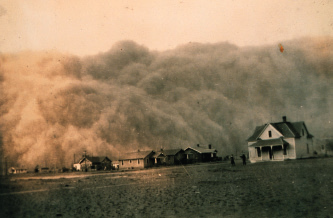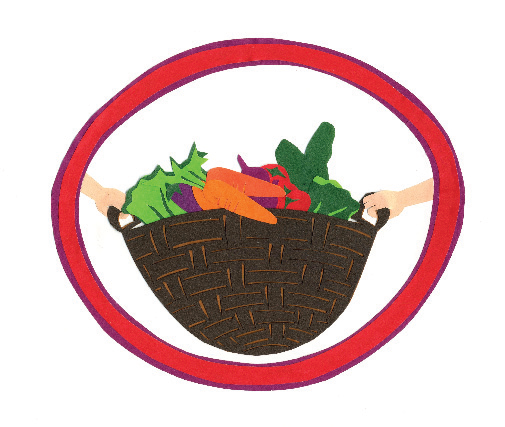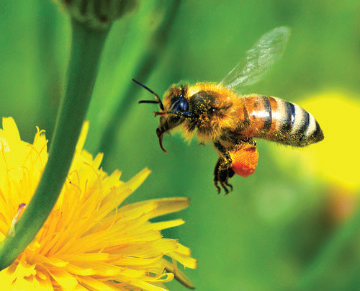The Science and Policy of Sustainability: An Exploration of the Conservation Stewardship Program
Tom Bogen, Kelsey Griffith, Rachel Keiser, Rebecca Kurnick, Chris Lane, Neil Mauws, Maxwell Moran, Joseph Old Elk, Scott Peters, Matt Schmidt, Jessica Smith
LRES Capstone Report
Montana State University, Department of Land Resources and Environmental Sciences
Catherine Zabinksi, Instructor and Karin Neff, Teaching Assistant
December 2011

Dust bowl storm approaching Stratford, Texas, 1935
http://weru.ksu.edu/new_weru/multimedia/dustbowl/dustbowlpics.html
- Without the implementation of soil conservation practices, extreme consequences from unrestrained agricultural production, like the Dust Bowl of the 1930’s, can occur.
- Continued use of r esource conservation practices on agricultural lands will enable us to attain food security for future domestic and international generations.
- Seven percent of the last Farm Bill was allocated toward conservation programs including the Conservation Stewardship Program (CSP).
- CSP encourages conservation practices regarding: air, plant, water quality, soil quality and erosion, animals, and energy.
- The current Farm Bill is being written under financial constraints and conservation programs are threatened to receive large funding cuts.
- Recommendations: We suggest that the CSP continue to be funded, be simplified to facilitate better producer-program interface, and provide funding for monitoring of results.
The Farm Bill: An Answer to Impacts of Agricultural Production
The beginning of the 20th century was a time of vast growth, development, and prosperity for the United States. In order to keep up with the growth, many agricultural practices were employed that were detrimental to ecosystems and soils. In 1931, there was a record wheat harvest across the nation, deflating the grain’s price across the board. Subsequently, farmers implemented extreme tillage and other practices to compensate for the decreased prices. However the farmers were unaware that an extended drought was setting in. The drought, coupled with extreme tillage of croplands across the nation, led to dust storms that indefinitely crippled the nation’s agriculture sector. The infamous Dust Bowl of the 1930’s was one of the most significant events in the history of American agriculture. As a r esult of these tumultuous times, Congress was forced into passing legislation to assist farmers (Egan, 2006). The Soil Conservation Act of 1935 was passed as a direct result of dust storms from the heartland reaching the nation’s capitol, and it is now better known as the original Farm Bill.
The Farm Bill came about to pr ovide equity and stability to the farmers of the United States. Effectively, the farm programs were designed so that farmers could be sustained given the highly cyclical nature of agriculture. The ramifications of Farm Bill policy reach many corners of society and agriculture. Farmers are provided with a safety net from the risks of factors that they cannot control (i.e. weather patterns, global prices). Farm Bill programs can also promote environmental management on farms, in particular subsidising improvements for water quality, soils, and wildlife through a variety of programs.
Maintaining Food Security

Image by Karin Neff
As the world’s population continues to grow, numerous countries have increased their grain production over the last few decades in an attempt to keep up with the rising demand (Rosenberg, 2001). To avoid exhausting natural resources that are fundamental to agriculture production, a balance between conserving those resources and production must attained.
After the dust bowl, soil conservation became a national security issue. Such a problem became a priority concern and was pr omptly addressed. The next challenge faced by the agriculture sector was attaining maximum yields, and after much research and focus, the agriculture sector can now produce maximum yields.
The issue agricultural producers face now is developing sustainable production methods. To aid in researching and developing these methods, programs such as the CSP must continue to develop and assist producers in attaining their goals.
We would like to thank the following for their assistance in preparation of this document: Linda Young, Rick Mulder, Adam Sigler, Senator Jon Tester, Dennis Dellwa, Joseph Fidel, and Kelly Polacek.
Encouraging Conservation through Monetary Incentives
Under the 2002 Farm Bill, Congress established the Conservation Security Program (CSP) and then later renamed and modified it to the Conservation Stewardship Program in 2008. The CSP is a voluntary conservation program that rewards farmers who use conservation practices on their farmland by using pay-for-practice incentives (Keeney and Kemp, 2003). The Conservation Stewardship Program is administered by the Natural Resource Conservation Service (NRCS) and is funded through the Commodity Credit Corporation (Cowan, 2008). Those who sign up for CSP are financially rewarded for employing resource conservation farming and ranching strategies. These stewardship incentives allow the individual producer to protect the environment while also creating an economically viable, income-producing farm (National Wildlife Federation, 2007). Through the CSP, environmental issues such as sur face water quality, fish and wildlife habitat, soil quality, air quality, and plant biodiversity were addressed and changed by implementing specific agricultural practices. These practices included diversified crop-rotation systems, no-till, cover cropping, conservation grazing, windbreak buffers and other resource conservation strategies (Keeney and Kemp, 2003).
How it works
NRCS ranks application and partially determines payout using the Conser vation Measurement Tool (CMT). Under CMT each application is given a point value for current conservation practices, proposed conservation practices, priority resource concerns addressed, and non-priority resource concerns addressed for each land use on the applied property. Each of the four sections is weighted against potential conser vation practices and multiplied by 0.25 to give each application a CMT point score. The application with the highest CMT score is accepted into the program until all allocated acreage for the state are filled. Under each land enhancement and conservation practice is a potential point value that can be rewarded to the CMT score for each priority resource concern that it addresses. Any land enhancements the property can potentially benefit from are considered potential conservation practices and are weighted against the CMT score. (NRCS, 2010)
Enhancements to Promote Pollinators

Image provided by texasbees.com
Many agricultural areas suffer from a lack of sustainable pollination systems, resulting from a shortage of managed, indigenous, or imported pollinators (Kevan et al., 2001). An example of how CSP enhancements can improve wildlife habitat and incr ease recruitment of certain species is PLT01: improving habitat suitable for insects. According to the 2011 CSP Montana Enhancement Workbook, this is accomplished by seeding vegetation that is favored by insect pollinators, such as species reliant on insect pollination for reproduction. These plants are seeded in non-cropped areas, like field borders, buffer strips, riparian vegetation, and other cover buffers. The increase in pollinators can lead to higher quality fruit and productivity per acre. This improvement in habitat will also provide a food base for additional wildlife species and may increase populations of other beneficial insects, reducing the need for pesticides. By implementing such practices and observing the favorable responses, agricultural production can be efficiently increased while decreasing its detrimental effects on the surrounding environment.
Improving Soil and Water Quality through Conservation Practices
Soil quality refers to a soil’s ability to per form specific ecological functions, including sustaining biological activity and diversity, water storage, filtering/buffering to change, and nutrient storage and cycling (Seybold, 1999). The rate of soil loss due to agriculture is much greater than that of soil formation (Fig. 1). Some conservation practices that address soil quality:
- Tilling on the contour reduces slope length by creating buffers of vegetation perpendicular to flow paths, to catch water and sediments.
